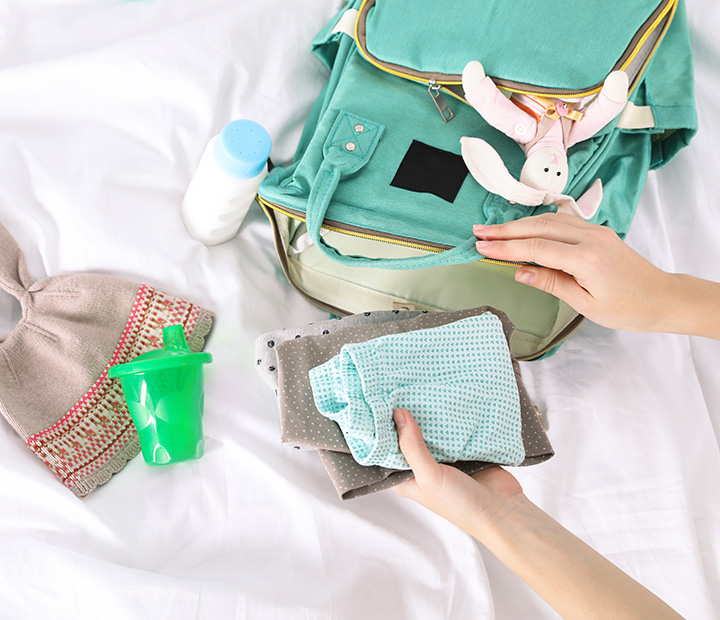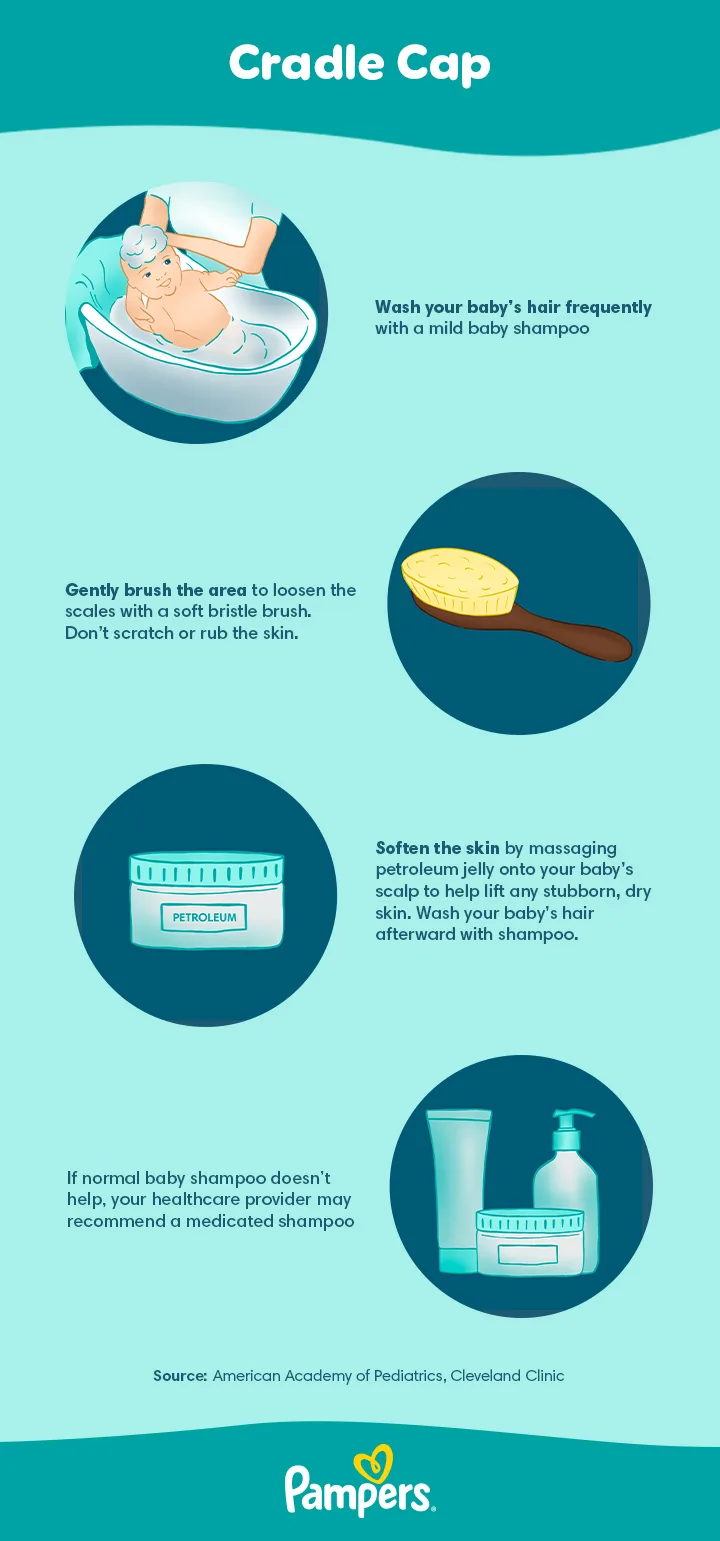What Is Cradle Cap? Understanding and Treating Newborn Scalp Conditions
Have you spotted dry, flaky patches or scales on your baby’s scalp or even around their eyebrows or ears? This common condition, known as cradle cap, or infantile seborrheic dermatitis, is often harmless and similar to dandruff in adults. While cradle cap may look a bit concerning, it normally doesn’t bother your little one and clears up within a few months. In the meantime, gentle cradle cap treatment steps may help soothe your baby’s skin and reduce the flakes.
What is Cradle Cap?
Cradle cap is a term for seborrheic dermatitis when it appears on a baby’s scalp, showing up as dry, flaky skin. However, cradle cap on the scalp isn’t the only place it may develop. In some cases, it may also appear on the eyebrows, ears, face, or other areas, such as the neck, armpits, and groin. When cradle cap affects areas beyond the scalp, healthcare providers refer to it as seborrheic dermatitis.
You might wonder, do all babies get cradle cap? While not every infant experiences it, cradle cap is very common, affecting about 70 percent of babies by the time they are 3 months old.
The good news is that cradle cap isn’t contagious, typically doesn’t cause pain or itching for your little one and leaves no scars as it gradually clears up.
When Does Cradle Cap Start?
Cradle cap most commonly appears when your baby is between 2 weeks and 12 months old. This form of infant dry scalp is common and typically harmless, causing little to no discomfort for your baby.
How Long Does Cradle Cap Last?
When does cradle cap go away? Cradle cap often clears up naturally within a few weeks or months and generally resolves by the time your little one’s first birthday. Since cradle cap is not contagious, there’s no need to keep your baby home from daycare or other activities. Although treatment isn’t usually necessary for this baby’s dry scalp condition, you may explore gentle options in our Cradle Cap Treatment section to help manage it at home.
Does Cradle Cap Come Back?
Cradle cap may sometimes reoccur within the first year, even after it clears up initially. Later in life, it may also return as dandruff when your child reaches puberty.
What Causes Cradle Cap?
The exact cause of cradle cap isn’t fully understood, but experts agree it’s not due to poor hygiene or a reaction to products. One possible factor is that certain pregnancy hormones may have passed from you to your baby before birth, leading to extra oil (sebum) production in the oil glands and hair follicles, which can trap dead skin cells. This explains why cradle cap normally appears on areas with more active sebaceous glands, like the scalp.
Another possible factor involves a natural yeast called Malassezia, which may grow in the excess sebum along with bacteria.
Cradle Cap Symptoms
Cradle cap symptoms may normally appear as:
Thick patches, scales, or crusts on your baby’s scalp
The infant’s head has dry skin and noticeable skin flakes
Patches that may feel greasy or waxy to the touch
Mild redness or inflammation around the affected areas
While cradle cap on the scalp is the most common, it may also show up on other areas, including the ears, eyebrows, eyelids, nose, and groin. Fortunately, this condition doesn’t usually cause any discomfort, itching, or pain for your little one.
What Does Cradle Cap Look Like?
Cradle cap often appears as red or moist patches of skin. On darker skin tones, these patches may look slightly lighter or darker than your baby’s usual skin colour. It may also show up as yellowish, greasy patches or areas that look scaly or flaky, especially on the scalp, behind the ears, or in the folds of the neck.
It’s easy to mistake cradle cap for dry skin conditions like eczema, but unlike eczema, cradle cap is typically mild and doesn’t cause itching or discomfort. If seborrheic dermatitis appears in your baby’s groin, it might resemble diaper rash, though the two are distinct conditions.
Cradle Cap Vs Dry Skin
While cradle cap and dry skin may look similar, cradle cap is usually identified by waxy or greasy patches or scales on the scalp, rather than dry flakes. If you’re uncertain whether your little one has cradle cap or another type of rash, consider consulting their healthcare provider.
Cradle Cap Treatment
Cradle cap generally doesn’t need specialized medical treatment and may often be managed at home. Healthcare providers may suggest trying simple cradle cap self-care techniques, like those listed below, to help gently reduce flakes and scales.
If at-home methods aren’t effective, your provider may recommend a stronger medicated shampoo, a mild hydrocortisone cream, or an anti-fungal cream.
Be sure to consult your healthcare provider before using any medicated products, as they may sometimes irritate your baby’s sensitive skin.
Cradle Cap Self-Care
Removing cradle cap scales might take time, but here are some gentle, effective remedies recommended by healthcare providers:
Wash your baby’s hair regularly, with a mild baby shampoo during bath time. If regular shampoo doesn’t help, ask your provider to suggest a medicated option specifically for cradle cap.
Use a soft-bristle brush to gently comb over the scales and loosen flakes without scratching or rubbing the skin. Rinse away any loose flakes with water.
For stubborn areas, try massaging a small amount of petroleum jelly onto your baby’s scalp to lift dry skin. You may also apply oil, such as coconut oil, to the affected areas but wash it out with shampoo after 10 to 15 minutes to avoid blocking oil glands, which may worsen cradle cap.
Always check with your healthcare provider before trying any home remedies or oils.
How to Avoid Cradle Cap?
While there’s not an exact way to prevent cradle cap, following some simple at-home practices may help minimize flakes and reduce the chance of them returning. Regularly washing your baby’s hair with a gentle shampoo and consulting your healthcare provider for additional guidance may be effective steps in managing cradle cap.
When to See Your Healthcare Provider
It’s a good idea to consult your healthcare provider if regular shampooing doesn’t seem to help, if the cradle cap appears severe, or if it shows up on areas beyond the scalp, such as your baby’s face or body. In cases where cradle cap persists, your provider may recommend a medicated shampoo, cream, or an anti-fungal treatment to help clear up the condition.
FAQS AT A GLANCE
Frequent shampooing with gentle baby shampoo and gently combing your baby’s hair may help loosen cradle cap buildup on the scalp. Over time, these simple steps may improve and reduce cradle cap.
The Bottom Line
Cradle cap may initially seem a little concerning, but it will resolve with time. You may help keep your baby’s skin healthy and comfortable by following the simple care tips above and general baby skin care practices.
For extra support on your parenting journey, consider using the Pampers Club app to access digital discounts and offers that can make caring for your baby a little easier.
How we wrote this article
The information in this article is based on the expert advice found in trusted medical and government sources, such as the American Academy of Pediatrics and the American College of Obstetricians and Gynecologists.
The content on this page should not replace professional medical advice. Always consult medical professionals for full diagnosis and treatment.
Join Pampers Club and get:







